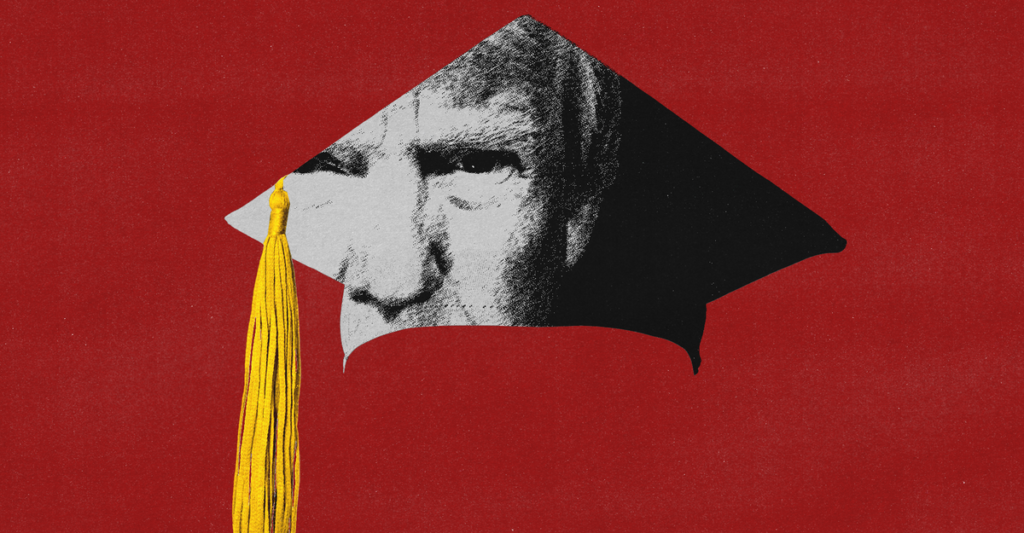The start of spring semester is a hopeful time on college campuses. Students fill the quads and walkways, wearing salmon shorts or strappy tank tops. Music plays; frisbees fly. As a career academic, I have been a party to this catalog-cover scene for more than 30 years running. It looks made-up, but it is real. Every year in the United States, almost 20 million people go to college, representing every race, ethnicity, and social class. This is college in America—or it has been for a long time.
But college life as we know it may soon come to an end. Since January, the Trump administration has frozen, canceled, or substantially cut billions of dollars in federal grants to universities. Johns Hopkins has had to fire more than 2,000 workers. The University of California has frozen staff hiring across all 10 of its campuses. Many other schools have cut back on graduate admissions. And international students and faculty have been placed at such high risk of detainment, deportation, or imprisonment that Brown University advised its own to avoid any travel outside the country for the foreseeable future.
Higher education is in chaos, and professors and administrators are sounding the alarm. The targeting of Columbia University, where $400 million in federal grants and contracts have been canceled in retribution for its failure to address campus anti-Semitism and unruly protests against the war in Gaza, has inspired particular distress. Such blunt coercion, Princeton University President Christopher Eisgruber wrote in The Atlantic earlier this month, amounts to “the greatest threat to American universities since the Red Scare.” In The New York Times, the Yale English professor Meghan O’Rourke called it and related policies “an attack on the conditions that allow free thought to exist.”
Those assessments are correct, but they’re also incomplete. So are the many paeans to the social and economic benefits of university research that schools have posted in the past two months. Yes, academic freedom is at stake, along with scientific progress. But the government’s attacks also threaten something far more tangible to future college students and their parents. The entire undergraduate experience at residential four-year schools—the brochure-ready college life that you may once have experienced yourself, and to which your children may aspire—is itself at risk of ruination.
Few administrators have talked about this risk in public, but they take a different tone in private as they try to figure out how broken budgets can be fixed. I’ve spent the past month discussing the government’s campaign to weaken higher learning with current and former college presidents, provosts, deans, faculty, and staff. And in the course of these informal, sometimes panicked text exchanges, emails, and phone calls, I’ve come to understand that the damage to our educational system could be worse than the public comprehends—and that calamity could arrive sooner than people expect.
Any one of the Trump administration’s attacks on research universities, let alone all of them together, could upend the college experience for millions of Americans. What’s at stake is far from trivial: Forget the frisbees on the quad; think of what it means to go to college in this country. Think of the middle-class ideal that has persisted for most of a century: earning a degree and starting a career, yes, but also moving away from home, testing limits, joining new communities, becoming an adult.
This might all be changing for fancy private schools and giant public universities alike. If you, or your son, or your daughter, are in college now, or are planning to enroll in the years ahead, you should be worried.
The familiar image of campus life was well established by the early 20th century. Whether a student was enrolled at Yale or Ohio State, they could expect to find the same mix of fraternities, coursework, and college sports; the same commingling of parties and protests.
At first that experience was limited to the wealthy. The American approach to higher ed had arisen from a melting pot of influences, some homegrown and others pulled from overseas. U.S. schools combined the practicality of land-grant institutions with the research focus of German universities. They borrowed also from British residential colleges, adopting both pastoral campuses and an aristocratic temperament. But after World War II, U.S. higher education was transformed. It quickly spread into the middle class, and helped expand it. The GI Bill, among many other efforts by the government, made college more accessible. Federal funding for research turned the college campus into a source of valuable expertise, and the locus for its own, growing set of jobs. And the rise of the knowledge economy made the skills one learned in college more desirable for all. In 1940, only 5 percent of American adults had earned a bachelor’s degree. By 1960, 45 percent of high-school graduates were enrolled in college; by 1997, that figure reached 67 percent.
All of this seems natural to Americans, but it was, and is, an unusual way to handle higher learning. Elsewhere in the world, colleges are not defined as mediators between childhood and adulthood. They may not be specific places where a student “goes” (as in the common formulation “I went to college”) but rather sets of nondescript buildings interwoven with cities. Only in America could “college” refer to the amalgamation of a coming-of-age experience and a credentialing service, based in a planned community that was mainly built to facilitate scientific research but also provides diversion, dining, and professional-quality sporting events.
As this peculiar form of college life expanded, Americans became attached to it. Many meet their future spouses while in college, then settle down not far away from where they went to school. Many cheer for their alma mater’s teams on television. Many send their alma mater money every year. College life stretches far beyond the years they spend on campus. In a way, it even stretches beyond the people who take part in it directly. It imbues the culture.
But creating this experience has always been just one of many, varied roles that schools must play. Tens of thousands of people—undergraduates, but also faculty researchers, administrative staff, and residential-life personnel—might go about their business on a given campus unaware of the purposes of those with whom they cross paths. Amid this web of private factions and concerns, the day-to-day routines of students—their “college experience”—can be a fragile thing. One part of that experience is learning: going to class, pursuing a major, studying, doing research, and completing a thesis. But for the schools, the cost of providing these activities doesn’t balance with tuition revenue. In 2024, Columbia spent about $3 billion on instructional expenses, facilities costs, and operations. It took in about $1.75 billion in tuition and fees (such as room and board). The balance is made up by combining revenue from all across the campus, including money that comes in from its investments, for example, or from taking care of patients at its hospital.
That’s why even just the Trump administration’s first strike against its targets—a mass curtailment of science-research funding—could end up being felt by students right away. At research universities, federal grant dollars may represent 15 to 25 percent of overall budgets. Even schools with huge endowments—Columbia’s is about $15 billion, for example—lack an easy way to fill the gaps, because that money may be spread across thousands of accounts, each of which may have rules for how it can be spent. Cutting grant dollars so substantially and unexpectedly cannot be addressed in a way that limits the impacts of those cuts to research alone. Something else will have to give.
If a school’s athletics program is unable to cover its own costs, it may need to scale back spending on its sports teams. I’ve also heard from colleagues at schools across the country that construction projects have been scrapped, that study-abroad programs are getting canceled, and that career services face cuts. In the meantime, faculty hiring freezes such as those adopted at Harvard, the University of Pittsburgh, and the University of Vermont could mean that fewer classes will be taught next year.
And all of that could be just the beginning. About one-third of U.S. college students rely on federal Pell grants, a financial-aid program for low-income families. That program was already facing a shortfall, and now the Trump administration is dismantling the Department of Education and its Office of Federal Student Aid. The White House claims that financial-aid programs will be unaffected, but personnel who manage those grants, other loans, and federal work-study programs now say they are unable to carry out their duties effectively. For students who rely on these funds, even short disruptions could end their college aspirations.
In the meantime, the need-blind admissions and no-loan financial-aid packages that many elite private universities have adopted over the past decade may start to seem untenable amid a budget crunch; top schools could focus on enrolling students whose families can pay top dollar, at the expense of everybody else. Public universities could respond to their duress by bringing in more, higher-paying students from out of state. (That trend is preexisting, but it could get much worse.) And those who can’t afford the rising costs would be relegated to community colleges and online degrees—useful options, but far removed from the cherished image of American higher education.
The point is this: It’s not just research; all of the trappings of college life are potentially at risk, and soon. If the campus experience is able to survive, it may revert to a more elitist, century-old version of itself, where the sons and daughters of oligarchs are among the only students on its lawns.
Those who plan to study the humanities may have the most to lose. The speed and scale of funding cuts demand immediate action, one top administrator at a state flagship university told me, and that could put programs in English, natural languages, art history, and the like into the crosshairs.
Doctoral students in such fields are mostly paid out of general university funds, which means that their salaries could easily be reclaimed and used as filler for any budgetary holes. (In contrast, money tied to research grants must be spent in certain ways.) But these same grad students also teach large numbers of undergraduates, so losing them might cause a university’s course catalog to shrink. When fewer people are on campus to teach humanities classes, fewer humanities classes will be taught on campus.
It doesn’t help that the programs the White House seems most interested in targeting are found in the humanities. At Columbia, for example, the Department of Middle Eastern, South Asian, and African Studies has been stripped of its independence in accordance with one of the Trump administration’s specific demands. Another, related problem is that the humanities faculty are already alienated from the grant-funded research mission of the postwar university. Professors of cultural studies, or history, or the arts, have long seen themselves as critics of institutions, including the universities that employ them. At Columbia and elsewhere, the attack on research funding is only worsening intrafaculty resentments that have been felt for decades.
The present crisis also carries existential risks for general education, the part of college that requires students to take courses from across the curriculum. Some humanities departments with shrinking majors have been able to persevere in part by fostering humanistic education and scholarship on campus. But the state-flagship-university administrator said that just this sort of work may start to seem expendable, at a time when STEM investments are imperiled.
For the coming crop of undergraduates, cuts to the humanities, paired with the collapse of general education, would alter the foundations of their college experience. The long-standing idea that you go to college to discover your interests and abilities—to “find yourself”—would be replaced by a full embrace of professional training. Admittedly, this change has already been in the works for years, even at prestigious schools: The rising cost of college makes experimentation more difficult to justify, and students have grown more market-focused over time. Up until this point, even the most practical-minded among our undergraduates could still balance their vocational majors with breadth-giving minors, or see the benefits of merely a passing exposure to other fields and forms of inquiry. But now the university—a home for all knowledge, universally—could be forced to downsize its ambition.
“Our problem in part is a failure of imagination,” Lee Bollinger, a former Columbia president, told The Chronicle of Higher Education earlier this month. “We cannot get ourselves to see how this is going to unfold in its most frightening versions.” Now the most frightening versions are taking shape, as specters in the hallways of the ivory tower. Jobs are being cut, labs closed, building projects canceled. Faculty members may decide that their devotion to the pursuit of knowledge may not be worth the occupational risk. Those in science, medicine, and engineering whose grants have been withheld may start exiting for jobs abroad or in industry while they still can.
The college experience could very soon be one that bears little semblance to the classic picture. Your kid could end up on a campus with reduced student services and activities, aging rec centers, shrunken-down humanities departments, less prestigious faculty, and a class cohort that has been stripped of foreign students, and also thinned of anyone who happens not to be well-off. It could be a dreary and degraded version of the life at school that you may have once enjoyed yourself.
College students’ prospects would have been slightly better if the schools had seen this coming. Attacks on higher education are not new, but they have never been waged at this level and this speed. The government has at other times threatened to withhold funds from universities in order to enforce federal law, but such examples have been “rare and marginal,” David Labaree, a Stanford historian who studies higher education, told me. That may be why no university in America was prepared for this assault, and none seems ready to respond.
Neither the White House nor the Department of Education responded to a request for comment for this story. But even the most enthusiastic advocates for going after higher ed may have been surprised by the intensity of the Trump administration’s actions. Max Eden, a senior fellow at the American Enterprise Institute, suggested in an essay for the Washington Examiner in December that the new regime, and its then-presumptive education secretary, Linda McMahon, should increase the endowment tax on universities and threaten to withhold federal funds to bring them into line on matters of DEI and anti-Semitism. “To scare universities straight, McMahon should start by taking a prize scalp,” he wrote. “She should simply destroy Columbia University.”
Eden, who did not respond to a request to comment for this story, seemed to expect at least some kind of formal process for this scalping. In the bloodthirsty scenario laid out in his op-ed, McMahon would threaten Columbia before cutting off its funds. In fact, the Trump administration cut off those funds just days after McMahon had been confirmed, and before demands were even made. Then it pressed for multiple concessions before the school would have any opportunity at all to negotiate for the funding to restart. The Justice Department attorney Leo Terrell insisted that the school was still “not even close” to having its funds unfrozen; the next day, Columbia gave in.
For two months now, universities have had no idea what, if anything, might stave off further punishments. The state-flagship-university official I spoke with admitted to hoping that the problem will just go away. Perhaps one scalp will be enough, a message sent. For the moment, though, the demands themselves (whatever those might be for different schools) seem less destructive than the sudden, chaotic application of extreme financial leverage: “It’s all arson and no architecture,” the official said. Universities might be amenable to adjusting the terms of their relationship with the federal government, but they cannot do so quickly and under such duress. The Trump administration appears to want them not to talk, but to die.
As for future college students and their parents, the campus experience they expect—the one that generations of Americans took for granted—is no longer guaranteed. Here on campus, the undergraduates seem unaware of this alarming fact. The crisis for universities may be existential, but another spring is blooming on the quad. College has persisted for a whole lifetime in its present form, in a pastoral setting, underwritten by federally funded research, with football crowds cheering in the distance. Last week, a student in my course on artificial intelligence bounded into the lecture hall, full of energy and optimism. “How was your break?” she asked. I’d designed the class to give undergraduates from across the university insights into the changes AI might wreak on their future professions, but just then I found myself wondering more about the future of my own. Not because technology may disrupt it, but because my own government seems intent on destroying it. “It was good,” I said, faking a smile, unsure of what to say. “It was good.”
Premium IPTV Experience with line4k
Experience the ultimate entertainment with our premium IPTV service. Watch your favorite channels, movies, and sports events in stunning 4K quality. Enjoy seamless streaming with zero buffering and access to over 10,000+ channels worldwide.

















